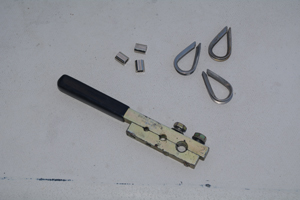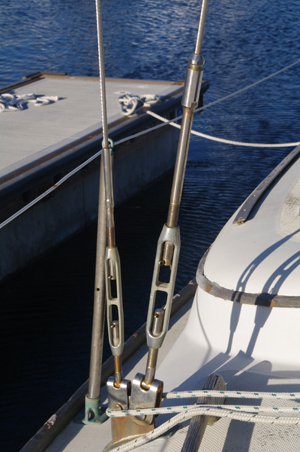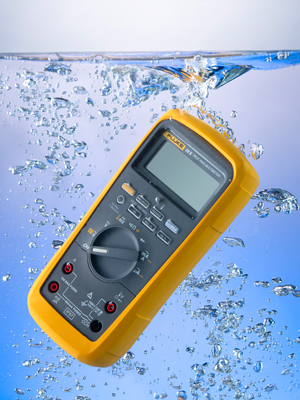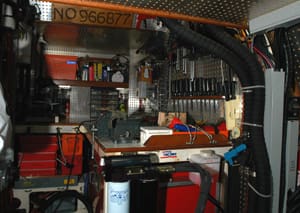The launch date for your first bluewater passage is less than a month away, and still you find troublesome holes in your inventory of tools and replacement parts. Is it necessary to carry one or two brand-new spare raw water pumps, or just extra shaft seals to rebuild the unit while underway?
Suppose your propeller gets severely bent by a heavy mooring line in some far-flung South Pacific anchorage, and you think you can hammer it back well enough to reach your next major port of call for a professional repair. Do you have a prop puller, or will you swing your ball-peen hammer underwater the way I was forced to do on my 1966 Cal 30 Saltaire in Lautoka, Fiji?
Even the most novice of sailors have on board their boats basic hand tools, such as those found in virtually every garage in the developed world (screwdrivers, socket and end wrenches, etc.), so I will not waste time on these items, except for a few specialty variations for marine use.
 |
|
Bill Morris |
|
A Swage-It Tool can produce sail pendants and other cables from 1/8-inch wire, thimbles and crimp sleeves. |
Drawing up a list of essentials with an eye to eliminating unnecessary, space-hogging items will help you sort out your vessel’s toolbox and spare parts list during the havoc of those last few weeks before slipping the mooring lines and setting out for your dream cruising ground. Foremost on the list of items likely to break down at sea yet reparable underway is your vessel’s rigging, both standing and running.
Rigging
Any vessel embarking on a major cruise of six months or more should carry, at a minimum, a spare length of 1×19 wire to replace the longest piece of standing rigging, plus an extra halyard and double-braided replacement sheets for each sail. In reality, high-quality sheets can last many years, sometimes through multiple circumnavigations, but better to err on the safe side.
Take along a coil of thin, inexpensive nylon rope to act as a messenger line to change halyards. Also, if your vessel uses servo-pendulum windvane self-steering, have available a couple of pairs of pre-cut double-braided lines to replace those controlling the helm.
Installing 1×19 rigging wire requires a pair of Norseman, Hi-Mod, or Sta-Lok terminals (commonly an eye fitting and a threaded stud). A neat trick for saving a stay or shroud frayed just above the stud fitting at the deck is to cut off the short damaged piece of wire, along with the terminal, and replace both with a long extension stud terminal. Avoiding the complete reinstallation of 1×19 wire permits faster, easier rigging repairs while hove-to at sea.
If you have an old coil of 7×19 flexible wire lying around, don’t throw it away! This wire, along with a handful of stainless thimbles and zinc-coated copper sleeves, enables you to fashion sail pendants, temporary replacement lifelines, hold-down wires, and even long cables for securing such valuables as a pair of oars, the outboard, and the dinghy itself.
Rigging wire cutters are available in a range of sizes. The small, one-handed cutters are great for snipping seizing wire and thin electrical wire, but for stainless rigging your best bet is a long-handled (two-handed) cutter, worth every penny when you try chopping through thick 1×19 wire.
 |
|
Bill Morris |
|
While on his circumnavigation, Bill Morris cut the swage off this lower shroud and replaced it with a used terminal extension he bought in the Dominican Republic. |
Although I have never carried a rigging wire tension gauge, Saltaire’s standing rigging might have fared better during her circumnavigation had I done so. Appropriate tension helps to prevent premature wear and crevice corrosion from working and overstretching, and also ensures proper mast contour, and yes, even correct hull shape. For hand swaging tools, you can choose either the Loos Lifeline Fitting Hand Swage Tool, which is easy to use yet quite large and expensive (nearly $300), or the pocket-size Swage-It Tool, available in two sizes, small (1/16, 3/32, 1/8-inch diameter wire) for just under $30, and the larger unit (1/8, 5/32, 3/16, 1/4-inch diameter wire) for just under $60.
The long-handled Loos Swage Tool has one drawback: it generally requires two people to operate the device, one squeezing the handles together while the other holds the wire in place, unless you have a bench vice handy to hold one handle stationary. Both tools, the long-handled and the pocket size, are intended for making eye splices in wire with stainless thimbles and zinc-plated copper sleeves.
Another indispensable item is a fid for making eye splices in three-strand rope. If you are accustomed to paying someone to make eye splices or rope-to-chain splices with three-strand line, now is the time to wean yourself off those services and master these traditional rope techniques.
Sail repair
My heart goes out to every cruiser I see sitting on a cabin roof with a fat roll of sail tape trying to mend a tear in a genoa. In my experience, the only way sail tape works for more than five minutes is when a needle and waxed nylon thread pass through the tape along the edges of the tear and around the edges of the tape to give the repair half a chance of working. If nothing else, the sail tape keeps the cloth edges from creeping while you sew.
For sewing, always carry a set of high-quality needles with big eyes to accept thick sail thread, plus a leather palm aid to send needles through dense layers of Dacron cloth. Bainbridge, the well-known supplier of sail cloth and thread, offers a set of drop forged needles shaped specifically for piercing multiple layers of thick canvas, and their “Speedy Stitcher Sewing Awl” allows you to make machine-like stitches through heavy cloth. What’s more, the sewing awl fits in your pocket and is reasonably priced at under $30.
Engine and drive train
Preventive maintenance is the key to survival for your vessel’s engine and transmission. Before leaving port, stow at least three spares of the following: oil filters, primary and secondary fuel filters, and air filters. Delo and Rotella-T oil for diesel engines is available in virtually any place of human habitation, but you should still carry enough for at least one oil change. Automatic transmission fluid is also readily available, but stow enough for at least one fluid change, particularly if you are staring down the bore of the northern Red Sea or the coast of Baja California and possible long hours of motoring into gale-strength winds and towering seas.
Amazingly, if you are anchored in a major cruising port, such as Maeva Beach, Tahiti, where there may be 300 or more vessels swinging at the hook, you would be hard pressed to find a single boat with a prop puller. Yet chances are, half of them will need one before returning home. Save yourself a lot of grief by laying out some money for a prop puller. The Pro-Pull is available in two sizes: small, to fit a one-inch to one-and-a-half-inch shaft (about $235) and large, to fit 1-5/8 to two inches (roughly $255).
Other power train goodies that come to mind: raw water pump impellers, shaft packing, packing extractor, packing nut wrench, clevis pins for prop, extra prop nut, several shaft zincs, and a handful of heat exchanger zincs.
Plumbing
A healthy assortment of plumbing supplies not only guarantees fresh water to the galley and head sinks, it also means keeping your vessel afloat and the engine properly cooled.
Crevice corrosion is the mortal enemy of every stainless hose clamp ever made, so carry a pile of these in every size installed on your precious floating castle. A wooden plug should also be tied to each through-hull for easy deployment in case one of the cast bronze fittings breaks from corrosion. Also worth carrying are complete rebuild kits for the head, faucets, and manual bilge pumps. Electric utility pumps have changeable impellers similar to those in engine raw water pumps, but 12-volt bilge pumps commonly die from motor failure, so it is best to carry a complete new spare.
Electrical
The degree of complexity of each vessel’s electrical system will dictate the list of spares and repair materials to be packed in the electrical kit. Common to all vessels are copper or lead battery cable fittings, spare LED or halogen bulbs, various gauges of marine-grade wire, coax cable connectors, eye and snap connectors and cable ties.
 |
|
Courtesy Fluke Corp. |
|
A multimeter, like the Fluke 28 II digital multimeter which is fully waterproof and dustproof, is an essential component of any voyaging tool kit. |
Soldering irons with two or three sizes of soldering wire, plus acid-free flux and a set of soldering tools, are also essential items for the cruiser’s electrical toolbox. Do yourself a big favor: before setting sail, think out exactly how and where you will perform soldering jobs without burning yourself or that beautiful teak table top, the pride of the main saloon. A piece of plywood at least one-foot square with a holding device for your work will make soldering safer, faster, cleaner and eminently less frustrating.
Another must-have is a high-quality digital multi-function tester, or multimeter. The Fluke 28 II is the ultimate multimeter for the offshore yacht, fully waterproof and impact-resistant up to a 10-foot drop. It also floats when stored in its yellow rubber holster. The Fluke 28 II measures up to 1,000 volts AC and DC, and up to 10 amps (20 amps for 30 seconds). With too many features to list here, this is the little beast you can trust to measure high levels of current from a wind generator, water generator or solar panel array with little worry about blowing out a fuse in the multimeter.
Running on three AA batteries, the Fluke 28 II boasts “backlit keypad buttons, large display digits and two-level bright white display backlighting for easy visibility in low-lit areas,” said Larry Wilson of Everett, Wash.-based Fluke Corp. The unit sells for about $430, a pretty penny for the shoestring cruiser, but on second thought, a real lifesaver when the health of your vessel’s electrical system depends on consistently accurate measurements.
At the lower end of the digital tester price spectrum is the Sperry 7-Function Digital Multimeter, capable of measuring up to 660 volts AC and 500 volts DC. Though not rated as waterproof, the unit sells for less than $45, making this a real bargain for cost-conscious voyagers.
Hull and deck
To aid with repairs to the hull and deck, remember marine sealants like the multi-purpose polysulfide bedding compound Life Calk, and for installations warranting a tougher bond, 3M 5200, or its less-than-permanent version, 4200.
Splash Zone Epoxy, that amazing stuff you knead with your bare hands and shmoosh into a hole in the hull where it hardens underwater, comes in a two-quart kit for about $135 and a two-gallon kit for a little less than $300. If there is one problem with carrying large amounts of Splash Zone, paints or other substances in steel cans, it is the tendency for the cans to rust at the bottom, where you are least likely to notice it. The solution is to transfer these products into plastic cans with tight-fitting lids and label them with a permanent marker.
Though you will find polyester resin in four-liter cans all around the globe, fiberglass cloth and tape can be in terribly short supply, so take along a few yards of six-ounce cloth and a roll or two of tape, along with a yard or so of woven roving, and seal them well from moisture. West System epoxy and fillers are generally available only in North America, American Samoa, New Zealand and Australia, though you might have some luck in Greece and Spain as well.
Few of us leave home planning major wood construction projects aboard our cruising vessels, but changes in lifestyle along the way may demand a collection of C-clamps, small furniture clamps (available at Harbor Freight Tools for less than $10), a healthy assortment of stainless fasteners, and waterproof Titebond III wood glue for interior construction.
Power tools
Powerful gensets and AC inverters on today’s cruising boats have made drill motors, jigsaws, handheld circular saws and Dremel tools nearly ubiquitous in even the tiniest of pocket cruisers. For more information on gensets, see my article, “Efficiencies of a genset” (Ocean Navigator, May/June 2011).
Drill motors with battery packs are in such abundance in terms of brands and models, it is pointless to review them here. Call me old-fashioned, but my trusty Skill 110-volt AC 3/8-inch reversible drill motor served me honorably around the globe and still does today, even after falling from the masthead straight into the brine while Saltaire was docked in Mooloolaba Harbor, Queensland. A freshwater bath and some WD-40 had it back in service the same day. The one big advantage? I never have to worry about recharging, or about replacing the battery pack in a 220-volt world outside the Americas.
Cruisers looking for one small tool taking the place of several larger devices appreciate the versatility of Dremel’s pair of multipurpose power tools: the Dremel 2-Speed Rotary Tool, ideal for cutting and sanding small surfaces, and the Dremel Multi-Max Tool Kit with its right-angled oscillating head, which can be used as a vibrator sander, hacksaw, or multipurpose saw for wood and plastic.
Dremel tools retail for less than $70, but face stiff competition from lower-priced knock-offs. Whichever you choose, the compact Dremel-style tool, particularly the oscillating head model, will find endless use aboard your vessel, cutting small planks to precise measurements and sanding corners where even your fingertips do not fit.
Marinized hand tools
Have you ever had a pair of long-handled channelized pliers freeze up from rust? Long periods of neglect at the bottom of a salty toolbox can render garden variety hand tools useless in a matter of months. One preventive strategy is to coat each tool in light machine oil, remembering to work the screw mechanisms in Crescent wrenches back and forth.
Marinized hand tools — that is, regular hand tools manufactured for marine use — will cost you somewhat more than the standard variety, but they pay off over the long haul in durability. Stainless steel pliers and wrenches are available online and in brick and mortar chandleries like West Marine at affordable prices. And what about screwdrivers falling into the bilge? West Marine offers a six-piece set of screwdrivers with floating handles and stainless shafts, just the thing for working near water.
The only possible disadvantages in stainless tools are a propensity for crevice corrosion and the lower tensile strength of stainless as compared to vanadium alloy steel. Best to carry both varieties — redundancy in hand tools is always a good idea.
Developing a list of parts and tools for your ocean passage will compel you to learn more about your vessel and about your own talents and capabilities as an ocean passagemaker. Your success as an ocean voyager will hinge on your pre-cruise planning and ability to anticipate potential problems on your vessel before they occur.
———–
Bill Morris completed a circumnavigation, two-thirds singlehanded, via the Suez and Panama canals aboard his 1966 Cal 30 Saltaire. He believes the main reason for the success of the voyage was careful planning, a preference for cost-saving manual systems, solar panels and windvane self-steering gear. Morris is the author of The Windvane Self-Steering Handbook, published by International Marine.

